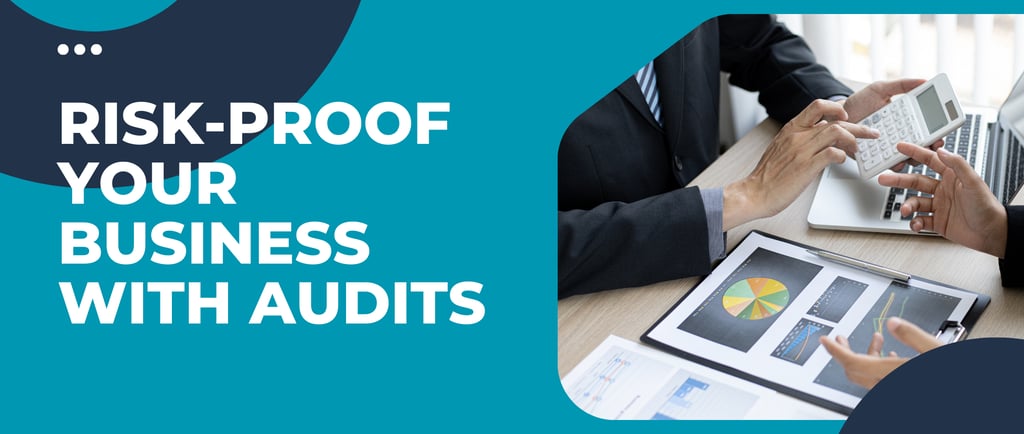Strengthening Business Security: The Intersection of Audit and Risk Management
This blog explores the critical role of audits in strengthening risk management, ensuring compliance, and enhancing business resilience.
3/8/20253 min read


Strengthening Business Security: The Intersection of Audit and Risk Management
Audit and risk management are essential components of a robust business strategy, ensuring transparency, regulatory compliance, and operational efficiency. These two functions work hand in hand to detect potential threats, reinforce internal controls, and enhance governance, ultimately fostering sustainable business growth.
Understanding Risk Categories in Business
Recognizing and addressing various risks is the first step toward effective risk management. Businesses face multiple types of risks, including:
1. Financial Instability Risks
These risks stem from economic downturns, fluctuations in interest rates, poor financial management, fraud, or inaccurate financial reporting. Businesses mitigate financial risks by maintaining strong financial controls and conducting regular financial audits to ensure transparency and credibility.
2. Regulatory and Compliance Risks
Failure to adhere to laws and industry regulations can lead to penalties, reputational damage, and legal consequences. Regular compliance audits help businesses stay updated with regulatory changes and implement necessary corrective actions to avoid legal complications.
3. Strategic and Competitive Risks
Market disruptions, ineffective decision-making, and a failure to adapt to industry trends can compromise a business’s long-term success. Businesses should continuously reassess their strategies, analyze competitors, and use data-driven insights to mitigate strategic risks.
4. Operational Disruptions and Process Failures
Operational risks arise from inefficiencies in internal workflows, supply chain disruptions, human errors, or system breakdowns. Strengthening internal controls, streamlining operations, and conducting operational audits help minimize these risks.
5. IT and Cybersecurity Threats
Cyber threats, including hacking, data breaches, and IT system failures, can severely impact business operations. Organizations must conduct regular cybersecurity audits to safeguard their digital infrastructure and enhance data security.
Types of Audits for Risk Mitigation
Audits serve as a fundamental tool for managing business risks. Different types of audits address distinct risk factors:
1. Financial Audits: Ensuring Financial Accuracy
These audits provide assurance regarding an organization’s financial integrity by verifying the accuracy of financial statements. Conducted by independent auditors, financial audits ensure compliance with accounting standards and instill confidence among investors and stakeholders.
2. Compliance Audits: Adhering to Regulations
Compliance audits evaluate whether a business is following relevant legal, regulatory, and industry-specific requirements. These audits help prevent legal risks and regulatory penalties by identifying non-compliance areas and recommending corrective measures.
3. Operational Audits: Enhancing Efficiency
By assessing internal workflows, operational audits help organizations identify inefficiencies and optimize resource allocation. These audits improve productivity, reduce costs, and enhance overall business effectiveness.
4. Internal Audits: Strengthening Internal Controls
Internal audits focus on evaluating risk management processes, governance structures, and internal controls. They provide real-time insights into business operations, helping management make informed decisions to mitigate risks effectively.
5. IT & Cybersecurity Audits: Safeguarding Digital Assets
As businesses increasingly rely on technology, cybersecurity audits have become crucial. These audits assess IT infrastructure, data protection policies, and cybersecurity measures to ensure resilience against cyber threats and data breaches.
How Audits Contribute to Effective Risk Management
Audits play a vital role in building a strong risk management framework by:
1. Detecting Potential Business Threats
Audits help uncover financial discrepancies, compliance violations, and operational inefficiencies before they escalate into major challenges. By proactively identifying risks, organizations can take preventive action to safeguard their business.
2. Strengthening Organizational Controls
By assessing internal controls, audits provide valuable recommendations to enhance security, prevent fraud, and improve operational efficiency. Strengthened controls reduce vulnerabilities and ensure a resilient business framework.
3. Improving Decision-Making Through Risk Assessment
Audit findings provide critical insights into risk exposure, enabling businesses to make well-informed strategic decisions. Risk assessments conducted during audits help organizations prioritize mitigation efforts based on risk likelihood and impact.
4. Ensuring Legal and Regulatory Compliance
Regular audits help businesses stay compliant with evolving regulations, reducing the risk of legal disputes and financial penalties. Compliance audits ensure that businesses adhere to industry laws and uphold their credibility.
5. Driving Continuous Improvement and Adaptability
Risk management is an ongoing process, and audits ensure businesses remain adaptive to changing risks. Through continuous monitoring and follow-ups, organizations can implement long-term improvements that align with industry best practices.
Conclusion
A well-structured audit and risk management system is essential for business sustainability. By identifying vulnerabilities, enhancing governance, and ensuring compliance, audits help businesses stay resilient and competitive. Instead of perceiving audits as a regulatory burden, organizations should embrace them as strategic tools for long-term success.
For expert audit and risk management solutions, book a consultation with ALWAHAT Accounts & Internal Audit Services.
Address
Faisal 2 Bldg, Office No 203, King Faisal St, Al Nad- Al Qasimia, Sharjah, UAE
Level 17, World Trade Center, Khalifa Bin Zayed, the first street- Abudhabi
Unit 32 -
4th Floor, AWR Properties - Al Fahidi Heights Office Tower, beside Central Mall ,near Sharaf DG metro station exit 4,Dubai ,U.A.E
Contacts
info@alwahataudit.com
+971589373943
We empower you to make well-informed decisions and successfully attain your financial objectives.


All copyrights reserved @Al-Wahat Accounts & Internal Audits | Designed - Abhijith.digital
Subscribe to our newsletter


